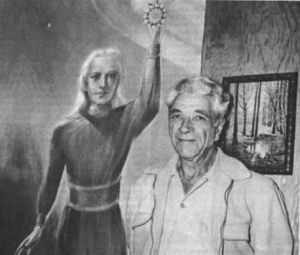The Grusch Affair continues to suck up the air in ufological space. The usual suspects continue to keep the story spinning (see this “roundtable” with George Knapp, Jeremy Corbell, Ross Coulthart, and Bryce Zabel, for example). In the mass(er) media, News Nation (…) isn’t much better, bringing together “experts” Sean Cahill, Steven Greer, and Avi Loeb for a yack. At least PBS for its part went to a journalist author of a forthcoming book on the matter, Garrett Graff. Even more serious thinkers are scratching their heads: Bernardo Kastrup (in a not very informed or profound manner) and Mike Cifone more scrupulously.
Those who swallow Grusch’s tale do so, it seems, for the most part, because they want to believe or on the grounds of the man’s credentials. Anyone who watched to the end a recent conversation between Mick West and Steven Greenstreet, however, would have been treated to a link that waves five red flags with Grusch’s story. The one that should catch the eye of everyone interested in the topic is that “in accordance with protocols, Grusch provided the Defense Office of Prepublication and Security Review at the Department of Defense with the information he intended to disclose.” Nothing Grusch has said is considered secret by the U.S. Department of Defense. So, is he blowing a whistle, or smoke?…

Some, such as those I’ve noted here earlier, Luke Harrington and Caitlin Johnstone, are able to look awry at the matter to consider its societal implications aside from the question of the factual truth of Grusch’s claims. Günseli Yalcinkaya, too, insightfully raises the point that “In this new and uncharted era of disinformation, it’s easy to see how stories of technologies of unknown origins, non-human intelligence and unexplained phenomena can fan the flames of cover-ups and conspiratorial thinking…” Thus, “it’s hard not to question the motives behind how this information is being fed to us – and why.”
Yalcinkaya is informed enough to recognize that the suspicion of cover-ups goes back to the beginning (however much she points to Roswell as the watershed event…). In fact, it’s in 1950 Frank Scully publishes tha archetypal crash-and-retrieval tale Behind the Flying Saucers; Donald Keyhoe publishes The Flying Saucer Conspiracy five years later, a title that underlines suspicions he’d been voicing from the start, in The Flying Saucers are Real (1950). In this regard, she quotes Mark Pilkington: “This UFO belief is intrinsically tied to notions of a government and military cover-up, and is powerful and pervasive within society,” a society wherein (as Yalcinkaya writes) “social media chips away at any notion of a consensus reality,…which amplifies fringe beliefs and makes it harder to distinguish what’s real or not.” Cannily, she observes that “Even the positioning of UAP sightings as classified information plays into this narrative, with officials capitalising on our collective distrust of mainstream media to uncover hidden truths,” this skepticism toward mainstream media further eroding a shared sense reality. “It’s important to consider why these conversations are entering the mainstream now” she goes on to write, “and it’s not a coincidence that it’s during a time when space tourism is on the rise and conversations around AI and non-human intelligence are reaching their peak and posing very real existential threats.” However much I find there to be more pressing concerns than those Yalcinkaya remarks, we would surely agree that The Grusch Show serves to keep “us distracted from anything more shadowy beneath the surface.”
Aside from distracting from graver problems (I’ve remarked Tim Burchett’s and Anna Paulina Luna’s skepticism about global warming…) and further dissolving consensus reality, the Grusch Affair stirs a deeper, troubling current, a particular, bipartisan suspicion of government. The roots of such distrust go to the very founding of the Republic, and, unsurprisingly, sprout after the Second War, one flower of which is precisely the myth of a UFO cover-up as articulated by Keyhoe. More acutely, “Big government” has been the target of Neoliberal attacks: Ronald Reagan famously stated that “government is not the solution to our problem; government is the problem.” This overt ideology has been behind the drive to rollback those gains made by working people after the war, particularly in the institutions of the welfare state. The consequences of such thinly-veiled laissez faire capitalism have not been for the best. And, at a time when then nations of the earth need work together over decades to mitigate and adapt to climate change (and other threats to life on earth), such a distrust of public institutions is, to say the least, counterproductive.
There is, morever, a blindness at work in this suspicion. “If there’s not a cover-up, the government and the Pentagon are sure spending a lot of resources to stop us from studying it,” Burchett told The Hill. His Republican colleague, Luna, adds, “We know that enormous sums of money are being spent on UAP-related activity, whether it’s retrieval/recovery, research and reverse-engineering, or just security for whatever the government is hiding.” This exclusive focus on government is curious, given that Grusch claims that “recoveries of partial fragments through and up to intact vehicles have been made for decades through the present day by the government, its allies, and defense contractors” [my emphasis]. The private sector, therefore, is no less guilty of a cover-up than government. Indeed, corporations have shown themselves no more transparent, when quarterly profits are at stake. Big Tobacco lied about nicotine’s being addictive, Big Oil knew about global warming, Boeing’s cutting corners crashed several 737 Max aircraft, and, more recently, Johnson and Johnson ignored research that linked its talcum powder to cancer. Ironically, it’s only via public institutions, such as the courts, that such corporate malfeasance can be brought to justice (not to mention the role of the much-maligned mainstream media in investigating corporate deceit).
Ideology (in the sense I use the term here) is revealed in such contradictions and omissions. By these same fissures and silences, UFO talk, as a social phenomenon, can’t help but betray, too, the “necessary fictions” that keep in place and reproduce the present order. “Disclosure,” therefore, is a mere distraction, from the true cover-up, of what’s at work in social reality, a reality of which UFOs/UAP are inescapably a part.
Talk of “nonhuman biologics” doubtless to many brings to mind “extraterrestrials” (however much the more informed might as much think of cryptoterrestrials, extradimensionals, or extratemporals). Wade Roush, in the excerpt from his book Extraterrestrials, surveys ideas about “the plurality of worlds” from the ancient Hellenic philsophers Leucippus and Democritus on down to the present day. Leucippus and his student are often credited with founding Atomism, “the belief that the visible universe consists of tiny, indivisible, indestructible atoms, churning in the void without purpose or cause.” Atomism, later, grounds the ethics of Epicurus and orients the great, scientific-epic poem of his follower Lucretius, On the Nature of Things. Roush quotes a telling passage from the poem:
If store of seeds there is
So great that not whole life-times of the living
Can count the tale …
And if their force and nature abide the same,
Able to throw the seeds of things together
Into their places, even as here are thrown
The seeds together in this world of ours,
’Tmust be confessed in other realms there are
Still other worlds, still other breeds of men,
And other generations of the wild.
Surely striking is how much the thinking here resembles that of contemporary astrobiology. The spatiotemporal immensity of the cosmos and the universality of the physical laws that govern it imply a likelihood of “Still other worlds, still other breeds” of life, sapient and “wild.”
I’ve proposed that the line of thought that posits that chemistry gives rise to life, which evolves to awareness and intelligence, which in turn develops technology is metaphysical, Platonic. And the deep, historical roots of the basic astrobiological schema, as evidenced in Lucretius’ poem, suggests, possibly, a no less deep, subterranean inheritance of related ideas in the sciences that are part of today’s Search for Extraterrestrial Intelligence (SETI). One could as well recognize in the thinking at work in Lucretius and SETI a version of the Eternal Recurrence of the Same, that the churning of matter over vast periods of time gives rise to the same patterns, especially if the universe is thought to be in a state of constant creation. The important question, in this regard, is if the thinking here is merely probabilistic or if this strictly statistical thinking is not, at the same time, however unwittingly, determined by a stubborn, metaphysical residue. Interestingly, Henri Poincaré posited that “certain dynamical systems, such as particles of gas in a sealed container, will return infinitely often to a state arbitrarily close to their original state.” Surely a matter for further research…

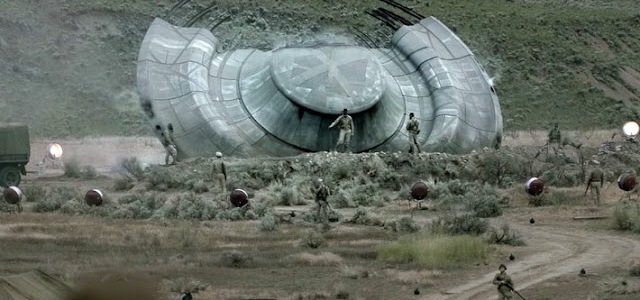
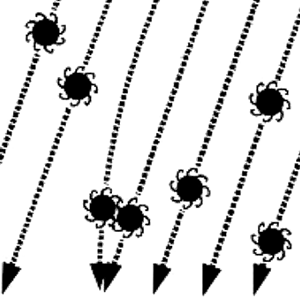






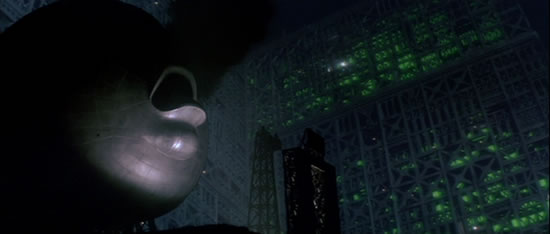





 Hand in hand with this motif is that of the insider able to access this otherwise secret or tactfully unpublicized information, a figure that has morphed, today, into the whistleblower. Keyhoe, as an ex-Marine pilot, maintained many contacts within the military and government. Most of the narrative of his books is conversations he has with these inside sources. The final chapters of The Flying Saucers are Real find Keyhoe studying over two hundred secret Air Force files released to him and his petitioning a general of his acquaintance for the more than one hundred he had been denied! This figure with access to inside information undergoes a change as the official relation to the phenomenon (at least in its public guise) develops from secrecy, to debunkery, to indifference. The truth is no longer obtained via official documents from official channels, but via leaked or hacked documents or whistleblower,
Hand in hand with this motif is that of the insider able to access this otherwise secret or tactfully unpublicized information, a figure that has morphed, today, into the whistleblower. Keyhoe, as an ex-Marine pilot, maintained many contacts within the military and government. Most of the narrative of his books is conversations he has with these inside sources. The final chapters of The Flying Saucers are Real find Keyhoe studying over two hundred secret Air Force files released to him and his petitioning a general of his acquaintance for the more than one hundred he had been denied! This figure with access to inside information undergoes a change as the official relation to the phenomenon (at least in its public guise) develops from secrecy, to debunkery, to indifference. The truth is no longer obtained via official documents from official channels, but via leaked or hacked documents or whistleblower, 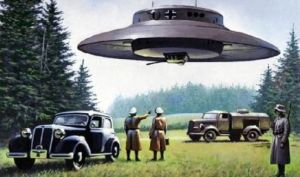 Here, the myth of the Nazi flying saucer, arguably first popularized by Holocaust denier
Here, the myth of the Nazi flying saucer, arguably first popularized by Holocaust denier 

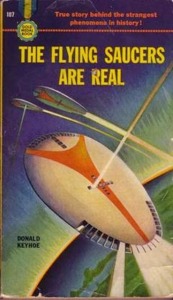 An important ufological popularizer of the ETH is Donald Keyhoe. In his first book, The Flying Saucers are Real (1950), he wrestles with the question of the origin of the flying discs. Having been pushed to the ETH by a process of elimination, he tries “to imagine how they [ETIs] might look” (136). Having read what he could of what we today call exobiology, he understands that there are “all kinds of possibilities.” Then, he makes a telling confession:
An important ufological popularizer of the ETH is Donald Keyhoe. In his first book, The Flying Saucers are Real (1950), he wrestles with the question of the origin of the flying discs. Having been pushed to the ETH by a process of elimination, he tries “to imagine how they [ETIs] might look” (136). Having read what he could of what we today call exobiology, he understands that there are “all kinds of possibilities.” Then, he makes a telling confession: